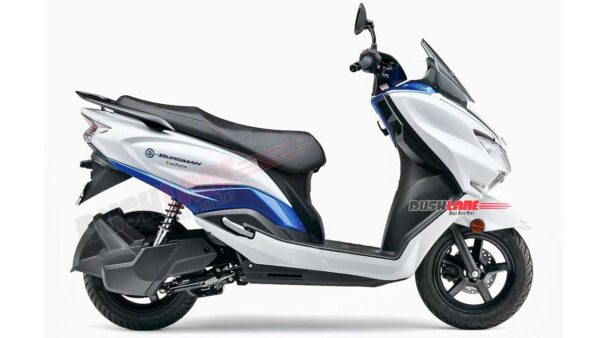Suzuki e-BURGMAN Electric Scooter: Features, Specs, Field Tests, and Battery Sharing Initiatives

Bajaj and TVS are the two mainstream two wheeler brands who have entered the electric scooter segment. Honda has just announced that they will launch two new electric scooters in India next year. Yamaha too has plans to launch electric scooters around the same time. And it seems, Suzuki will also be ready with their first electric scooter by then.
Suzuki Motor Corporation has announced an exciting new development in the world of electric two-wheelers – the e-Burgman. First official images and specs of Burgman electric scooter are now out. Already spied on test in India, the e-Burgman will now enter advanced test phase in Tokyo Japan.

Suzuki’s e-BURGMAN field tests: What to expect and why they matter
Burgman electric scooter is part of a larger effort to promote battery sharing and increase the use of e2Ws in Japan. Suzuki is working with Gachaco Co., Ltd., a Tokyo-based battery sharing service. Field tests will be conducted over three months, starting from April to June 2023, and will involve eight Burgman electric scooters.
Suzuki Motor Corporation staff and customers who apply will be participating in the field tests. Tests will help collect essential data through daily activities, such as commuting, going to school, and shopping. Data will be utilized to develop the production spec Burgman Electric Scooter.

Classified as a Class-2 light electric scooter, it boasts impressive specs. Suzuki e-Burgman can travel up to 44 kms on a single charge when ridden at a steady speed of 60 km/h. It has a rated output of 0.98kW, maximum output of 4.0kW, and maximum torque of 18Nm. Dimensions are as follows – length 1,825mm, width 765mm, height 1,140mm, seat height 780mm. Vehicle kerb weight is 147 kgs. It’s powered by a synchronous AC motor and equipped with a lithium-ion battery.

Swappable battery standardization: How the big four in Japan are leading the way
Suzuki is part of the Swappable Battery Consortium for Electric Scooters, which includes Honda Motor Co., Ltd., Kawasaki Heavy Industries, Ltd., and Yamaha Motor Co., Ltd. The consortium is working on standardising swappable batteries and replacement systems. A significant step towards battery sharing and increasing the use of electric two-wheelers in Japan.
Common specs were derived from the TP21003 technical paper. Development standards are fine-tuned for swappable batteries that address drive range and charging time concerns. Furthermore, the consortium has been collaborating with e-Yan OSAKA field tests aimed at promoting the adoption of electric scooters.
Honda Mobile Power Pack e: Making battery sharing a reality
The collaboration led to the establishment of Gachaco, Inc., a sharing service for standardised swappable batteries. ENEOS, Honda, Kawasaki Motors, Suzuki, and Yamaha Motor have all come together to offer a BAAS (Battery as a Service) solution. This allows electric scooters to travel longer distances, eliminating concerns about running out of battery charge. Gachaco services get underway with the use of Honda Mobile Power Pack e:, which is common spec compliant.
As battery sharing solutions become more accessible and reliable, eco-conscious riders will have a wider range of options for transportation. The future looks bright for the big four in Japan as they work together to increase the adoption of electric scooters in Japan and beyond. India launch of the new Burgman Electric scooter is expected sometime next year. Upon launch, it will rival the TVS iQube, Bajaj Chetak and the upcoming Honda Activa Electric. Suzuki Burgman electric price could be in the Rs 1.5 lakh range.

